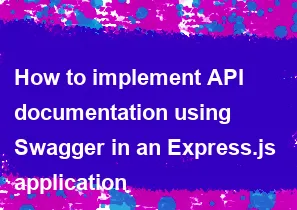How to implement API documentation using Swagger in an Express.js application

Swagger is a powerful tool for designing, building, and documenting APIs. It provides a way to describe the structure of your RESTful APIs so that both humans and computers can understand them. In an Express.js application, you can use the swagger-jsdoc and swagger-ui-express libraries to generate and display Swagger documentation. Here's a step-by-step guide:
Install Dependencies: First, install the required npm packages:
bashnpm install swagger-jsdoc swagger-ui-express --saveSetup Swagger Options: Create a new file, for example,
swaggerOptions.js, to define the Swagger options:javascriptconst swaggerJsdoc = require('swagger-jsdoc'); const options = { swaggerDefinition: { openapi: '3.0.0', info: { title: 'Express API with Swagger', version: '1.0.0', description: 'Documentation for Express API with Swagger', }, }, apis: ['./routes/*.js'], // Add your API routes file(s) }; const specs = swaggerJsdoc(options); module.exports = specs;Integrate Swagger UI in Express App: In your main Express application file (e.g.,
app.js), integrate Swagger UI:javascriptconst express = require('express'); const swaggerUi = require('swagger-ui-express'); const specs = require('./swaggerOptions'); // Import the Swagger options file const app = express(); // ... Your existing Express setup ... // Serve Swagger UI at /api-docs endpoint app.use('/api-docs', swaggerUi.serve, swaggerUi.setup(specs)); // ... Your routes and other middleware ... const PORT = process.env.PORT || 3000; app.listen(PORT, () => { console.log(`Server is running on port ${PORT}`); });Document Your API Routes: In your Express route files, add Swagger annotations using JSDoc comments. Here's an example:
javascript/** * @swagger * /api/users: * get: * summary: Get all users * description: Returns a list of all users * responses: * 200: * description: Successful response * 500: * description: Internal server error */ router.get('/api/users', (req, res) => { // Your route logic here });Generate and View Swagger Documentation: Run your Express app and navigate to
http://localhost:3000/api-docsin your web browser. You should see the Swagger UI, which provides interactive documentation for your API.
That's it! You've now integrated Swagger documentation into your Express.js application. Remember to update the Swagger annotations in your route files as your API evolves.
-
Popular Post
- How to optimize for Google's About This Result feature for local businesses
- How to implement multi-language support in an Express.js application
- How to handle and optimize for changes in mobile search behavior
- How to handle CORS in a Node.js application
- How to use Vue.js with a UI framework (e.g., Vuetify, Element UI)
- How to configure Laravel Telescope for monitoring and profiling API requests
- How to create a command-line tool using the Commander.js library in Node.js
- How to implement code splitting in a React.js application
- How to use the AWS SDK for Node.js to interact with various AWS services
- How to use the Node.js Stream API for efficient data processing
- How to implement a cookie parser middleware in Node.js
- How to implement WebSockets for real-time communication in React
-
Latest Post
- How to implement a dynamic form with dynamic field styling based on user input in Next.js
- How to create a custom hook for handling user interactions with the browser's device motion in Next.js
- How to create a custom hook for handling user interactions with the browser's battery status in Next.js
- How to implement a dynamic form with dynamic field visibility based on user input in Next.js
- How to implement a dynamic form with real-time collaboration features in Next.js
- How to create a custom hook for handling user interactions with the browser's media devices in Next.js
- How to use the useSWRInfinite hook for paginating data with a custom loading indicator in Next.js
- How to create a custom hook for handling user interactions with the browser's network status in Next.js
- How to create a custom hook for handling user interactions with the browser's location in Next.js
- How to implement a dynamic form with multi-language support in Next.js
- How to create a custom hook for handling user interactions with the browser's ambient light sensor in Next.js
- How to use the useHover hook for creating interactive image zoom effects in Next.js